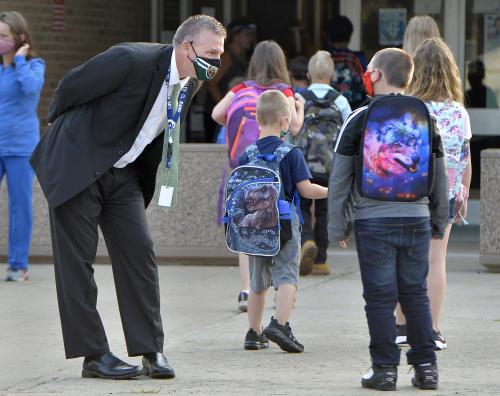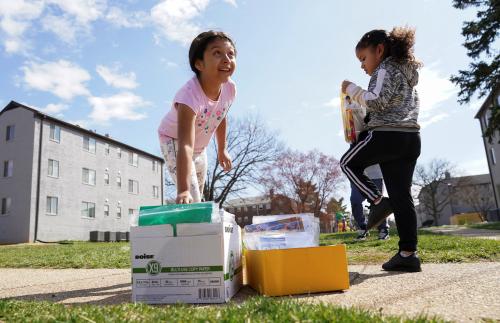A student’s readiness to learn is often dictated by factors outside of the classroom. The pandemic highlighted the critical roles of food and housing, social and health services, supportive relationships, and youth development opportunities to student well-being and academic progress.
As schools work to remedy the negative impacts the pandemic had on students and families, educators are especially attuned to schools’ need for high-quality “student support” services. Combined with an influx of funding from federal pandemic relief aid, these circumstances have stoked demand and attracted new players to the student support market.
School districts are now inundated with “student support” service providers but have little guidance on how to select or manage them. Direct service providers–like afterschool programs and eyeglass distributors–are increasingly joined by “integrated student support” providers who specialize in how to identify student strengths and needs and then coordinate the services and opportunities available in the school, and the surrounding community, to get the right resources to the right student at the right time.
When implemented well, integrated student support drives improvements in student learning outcomes, school climate, and teacher job satisfaction. This model also benefits taxpayers by more efficiently using school and community resources to produce positive short- and long-term outcomes.
With the field’s increasing understanding of what effective student support strategies look like, policymakers should establish quality benchmarks to help districts ensure a minimum, evidence-based standard of care for students.
Managing risks and benefits in a dynamic market
New players are increasingly engaging in assessing what students need and coordinating available resources in the school community. For example, an established organization like nonprofit City Year is training Americorps members to become “student success coaches;” for-profit Panorama is building on its social-emotional screening tools to enable a whole child approach to student support; and new entrants like Welfie pledge to support schools with “an innovative Full Service Community Schools Program.”
These organizations and others are expanding the options for schools interested in developing effective integrated student support systems. They can bring innovations and cutting-edge technology, tie interventions more closely to best practices based on research, and leverage more people in schools and communities with valuable ways of supporting students. At the same time, policymakers must balance the promise of innovations with risks.
Just as the Food and Drug Administration strives to ensure that the health benefits of a new treatment outweigh potential harms, policymakers in education can use evidence to minimize potential risks and maximize the benefits of student support interventions.
Contemporary student challenges can be exacerbated by approaches that fall short of best practices. For example:
- Mishandling information: Inadequate training of personnel can lead to mishandling student and family information, risking student safety and school liability;
- Dropping the ball: A student shares a traumatic experience on a school-administered questionnaire but there is no follow-up, exacerbating the student’s feelings of isolation and helplessness and raising the risk of adverse student outcomes;
- Missing the target: Ways to identify students with needs may not be reliable, allocating resources–including special education services–away from students who need them most.
Growth in the market for student support services must be met with an increased focus on ensuring that providers follow evidence-based best practices.
Creating Quality Benchmarks
The critical task of ensuring student support quality falls to a wide range of federal, state, and local policymakers. This should include Congress, the U.S. Department of Education, Health and Human Services, state departments of education, state health and human services, state legislatures, and local school boards and districts. All of these entities have a part to play–whether through legislation, guidance, grants, or implementation support–to ensure that students receive a baseline standard of quality care and support, and that resources, supported largely by public funds, are used effectively and efficiently.
These entities do not need to develop quality standards from scratch; rather, both research and practice can provide guidance to policymakers at every level, illuminating conditions and proven practices that can minimize risks and maximize benefits.
The first National Guidelines for Integrated Student Support provide a roadmap for how all schools can improve their approach to student support. Through a process convened by the Boston College Center for Thriving Children, where we work, consensus guidelines were developed by a national group of experts in research and practice of integrated student support.
The guidelines are consistent with professional standards, such as those of the American School Counseling Association, and give policymakers parameters to set quality benchmarks to shape the growing marketplace. For example, a quality approach to student support will:
- Personalize support for every student;
- Be comprehensive in addressing a student’s strengths and needs in academics, social-emotional-behavioral well-being, physical health, and family dynamics;
- Function within the day-to-day operations of a school, creating a systematic approach;
- Leverage the personnel and resources available in the school and the surrounding community;
- Emphasize student support personnel credentials, competencies, training, and support; and
- Use data for continuous improvement of implementation and evaluation of outcomes while also honoring student and family privacy.
Across the country, more than 330 schools are following best practices in student support. They are reviewing each student’s needs, creating individualized plans, following up on those plans with a combination of school and community resources, and using data to inform school-level decision making with the help of City Connects and Building Assets Reducing Risks (BARR) Center. Another 2,900 schools partnered with Communities In Schools and still others are moving towards these best practices.
Federal policymakers are also making strides towards strengthening student support in schools. Recent actions include the National Partnership for Student Success, which released voluntary quality standards, and the Bipartisan Safer Communities Act, which invests in student support personnel and interventions. Yet these steps are moving slower than the marketplace is growing and the evidence of what works. The new National Guidelines can help policymakers align federal investments, including the Full Service Community Schools program, with evidence-based best practices so that more schools implement proven strategies.
States Leading the Way
Some state policymakers are more aggressively taking hold of the research in response to needs in their schools and communities. These states are creating demand for programs that are more likely to work for students. They are identifying interventions with defined models, aligned professional development, capacity to monitor fidelity of implementation, and a willingness to evaluate outcomes.
In Texas and West Virginia, for example, state funds are supporting the expansion of Communities In Schools. The integrated student support program places coordinators in schools to bring in needed resources and work with high-need students on individualized student support plans.
Similarly, Indiana is expanding City Connects (Disclosure: the authors are employees of the Boston College Center for Thriving Children, where the program is incubated). City Connects is an evidence-based approach to leveraging school and community resources to ensure that each student gets a tailored set of supports and opportunities to address their unique needs, strengths, and interests.
California’s $3 billion commitment to Community Schools, which includes integrated student support, is spurring the state to more rigorously define the approach and develop aligned technical assistance.
These states are taking important steps to help their schools and districts navigate a dynamic marketplace and encourage the uptake of approaches to student support more likely to yield benefits. We encourage more states to follow their lead.
Federal and State Policymakers Have Important Roles to Play
As the field of student support becomes crowded with new entrants capitalizing on financial opportunities and responding to significant student needs, policymakers at every level should establish baseline standards of quality and care. They can start by identifying research-based parameters and incentivizing the adoption of effective and cost-efficient solutions capable of mitigating harms and delivering on the promise of student support. Although coordination in disparate policymaking arenas can be challenging, a shared roadmap informed by research and practice—the National Guidelines for Integrated Student Support—we hope will prove to be a critical touchstone.
The National Guidelines for Integrated Student Support were developed by a working group of researchers from AIR, Boston College, Child Trends, Harvard University, Learning Policy Institute, University of Pennsylvania, and UCLA and practitioners from Building Assets Reducing Risks (BARR) Center, City Connects, Communities In Schools, the New York City Department of Education’s Community Schools, the National Center for Community Schools, and others. Learn more about the guidelines here.








Commentary
Amid rush of school support vendors, policymakers must monitor quality
February 22, 2023